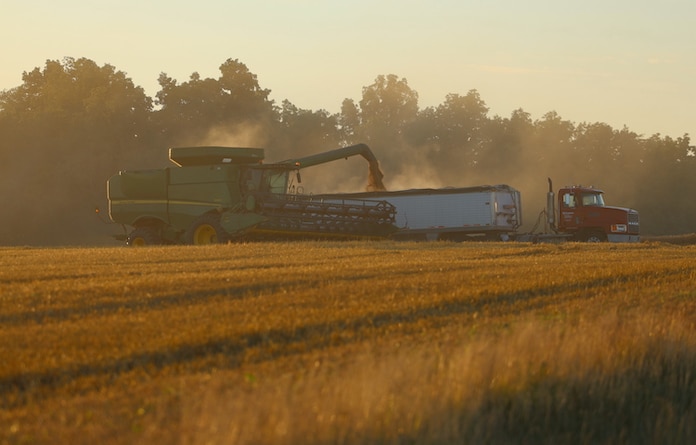Farmers brace for break-even year

In a sharp departure from last year’s drought, Monroe County farmers dealt with more-than-desired rain over the past month, though other factors could have them just hoping to break even this year.
Gateway FS Grain Originator Michael Biethman offered an overview of how area farmers seem to be doing, with rain managing to impact each of the three regional crop staples in one way or another.
When it comes to the wheat that is largely already harvested, Biethman said yields are notably better than last year but the quality is worse.
As he explained, several different factors contribute to the grain’s quality assessment, with one of the biggest factors being test weight.
The ideal test weight for a bushel stands at 60 pounds, though reports he’s seen seem to indicate test weights are down by two to three pounds – some even hitting 54 pounds and thus receiving a heavy discount when farmers sell it.
Moisture can also lead to grain discounts, as can damage from kernels trying to germinate as happens when farmers are unable to harvest and the crop is left in the field too long.
“It has been warmer but it has been wetter,” Biethman said. “The crops are under a different kind of stress than they were last year. Last year, I’m not gonna argue, it’s always hot in the summertime, but they just didn’t have any water. And this year it’s almost like they have too much.”
Soybean and corn planting has also been affected by the rain, with a more noticeable visual impact in the latter.
As Biethman said, some farmers were able to get their fields planted in early April, but others were forced to replant due to wet conditions and some have only been able to plant just recently, leading to some fields being far closer to “knee-high by the Fourth of July” than others.
“Planting was pushed back this year because of the wet weather, and there was some replants that had to happen because the low-lying areas, we got so much water that, if you had a low-lying field, you had to replant,” Biethman said. “I would say, compared to last year, planting was two to three weeks – maybe a full month – behind schedule.”
While the rain this spring has had some impact on farmers, Biethman also placed focus on overall prices.
He specifically honed in on corn, with this area seeing a very strong crop compared to the rest of the country in 2022.
A national surplus crop that followed led to a heavy reduction in the price, and lesser yields last year resulted in a struggle for farmers looking to make a profit.
“Yields were down last year. In October of 2023, we were getting reports, ‘Hey, I’m not getting 200 bushel corn. I’m getting something, but I’m not setting a record by any means,’” Biethman said. “So that’s like the theme. Guys did have a crop, it just wasn’t as good. It wasn’t a record by any means, and then on top of it you had corn with a four in front of it. And you’re getting close to break-even with corn with a four in front of it.”
The price per bushel for corn, soybeans and wheat in the past week stood at $4.37, $11.75 and $5.70, respectively.
Last year’s prices in mid-June were $6.26 for corn, $14.56 for soybeans and $6.60 for wheat. These numbers were also down slightly from 2022.
“You can see the notable decrease in cash prices, which is a decrease in revenue for the farmer, cash flow. All of that ties in,” Biethman said. “I think that they’re managing it because of two great years… but this year hurts. You’re much closer to break-even numbers at these commodity prices than you were a couple years ago.”
Looking ahead to the rest of the season and the year, Biethman said prices are largely too low to be buying crops, with the hope being that the price of corn rallies to $5 per bushel and soybeans rise to $12.
When it comes to weather, the real hope is for fields to get the rain they need when they actually need it now. This means wishing for showers when the corn is tasseling in July and as the recently planted double-crop soybeans need their water in August.
“With replants, you’re gonna need rain in late July too, because some of the stuff that’s just planted, it might not be tasseling until the middle or late July,” Biethman said. “July weather is going to be very important to the corn crop. And then on the bean side, we need some August rains for these double-crop beans.”
Hearing from local farmers, the sentiments about spring rain and crop prices are largely the same, though the situation varies from farm to farm.
Dale Haudrich, who farms near Hecker, reported that his wheat’s test weight was rough compared to last year, with heavy rains over the course of two weeks seeming to lead to a 40-cent dock.
“Rain is good, but not the amount that we got in that short a period of time,” Haudrich said.
He also mentioned having to replant his soybeans in the past few weeks. Additionally, Haudrich was one local farmer who was unable to get his corn planted before the rain kept him out of his fields.
“My corn is actually good, it’s just way behind,” Haudrich said. “Some of my neighbors, as I look down at the road and see some of the neighbors’ fields… It’s got a long way to go yet. If this summer behaves with decent weather, we’ll have a good crop.”
Haudrich offered a comparison to last year’s drought, adding a general assessment of the rain’s impact.
“It was a lot easier on your conscience and your patience, I guess, last year,” Haudrich said. “This year we started planting, and it was actually three weeks until we got back into the field again to even think about replanting… It was quite a frustrating stint there for a while that we had to sit on our laurels and wait for Mother Nature to cooperate once again.”
Though he noted the decrease in grain prices and the upsetting comparison between them and the cost of his seasonal inputs, Haudrich also pointed out that it’s simply too early in the year to call it a success or failure.
With acreage primarily in the bottoms, Bruce Brinkman gave a rather opposing assessment as he said the rain hadn’t managed to hit him too hard.
Brinkman also didn’t have much to say about the wheat harvest, as he didn’t plant all that much. What he has harvested has also been placed in bins for storage, though he has heard plenty about both good and bad test weights this year.
When it comes to a general assessment, Brinkman was quite positive, with input costs on his end not looking too bad compared to prices.
“I’m feeling pretty good. It’s kind of one of those where, yes, the price is down, but also our input costs are down this year, so that is going to help on the long end,” Brinkman said. “Now, so much of that all depends on how much of a crop you’re gonna have and what kind of demands we have.”
He also noted how his operation looks slightly different compared to those farmers in the county purely working the fields as he also raises swine, so the cost of grain, namely soybeans, can serve as a boon for him even if it’s down.
Brinkman’s takeaway at this point in the year was comparable to that of Biethman, with income looking to be rather middling instead of having any massive profits or losses.
“This year’s really just kind of setting up right now to be one of those average years, the way it looks at this particular time,” Brinkman said. “You’re not gonna make a bunch of money, but yet I don’t think you’re gonna lose a bunch of money either. It’s gonna be one of those pretty much across-the-line, break-even kind of years. Which is OK. We can’t have great years every year.”
Rich Guebert, who farms near Red Bud, said he just recently finished planting his soybeans, with his wheat harvest close to wrapping up and his double-crop soybean planting to follow.
He has similarly encountered a poor quality wheat harvest seemingly due to the wet weather over the past month.
“The test weight has been disappointing, but beautiful weather for it,” Guebert said. “I kind of attribute the poor test weight to the spring weather patterns.”
Guebert said some of his corn fields were planted early while others came more recently with just around a 10-15 day delay.
He noted that sources he’s read or heard from seem to expect a rough year. Guebert notably brought up an increase in interest rates and how this seems to be impacting sales for John Deere as farmers opt to hold off on equipment purchases.
“It’s gonna be tough for a profit this year,” Guebert said. “Margins are gonna be really narrow. Interest rates have not come down. That impacts the number of farmers that have money borrowed. What we’ve seen is farmers pull back on their purchase of new equipment.”
Guebert also spoke to a need he sees on the national scale, with increased corn and soybean exports potentially benefitting farmers as they hope for improved prices.






